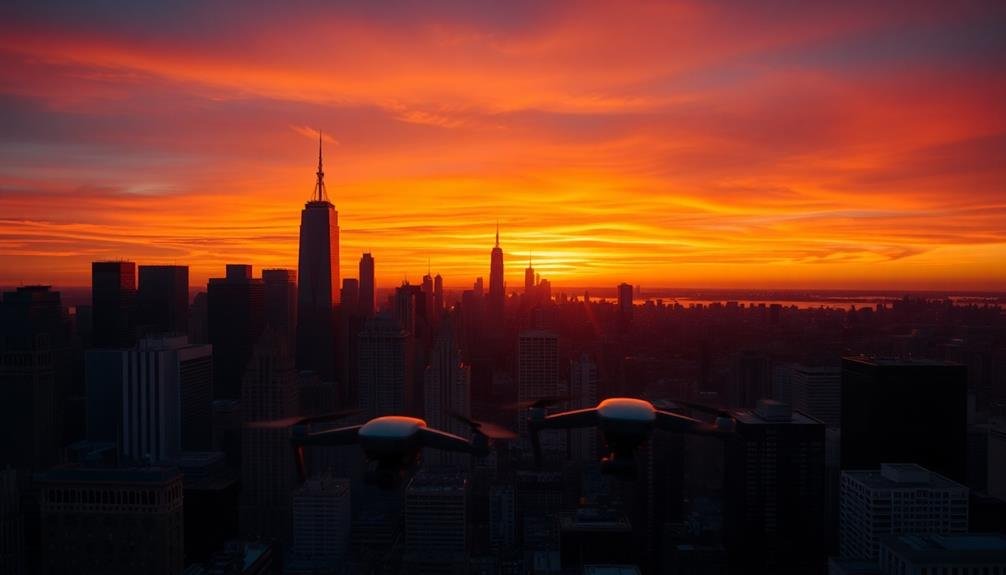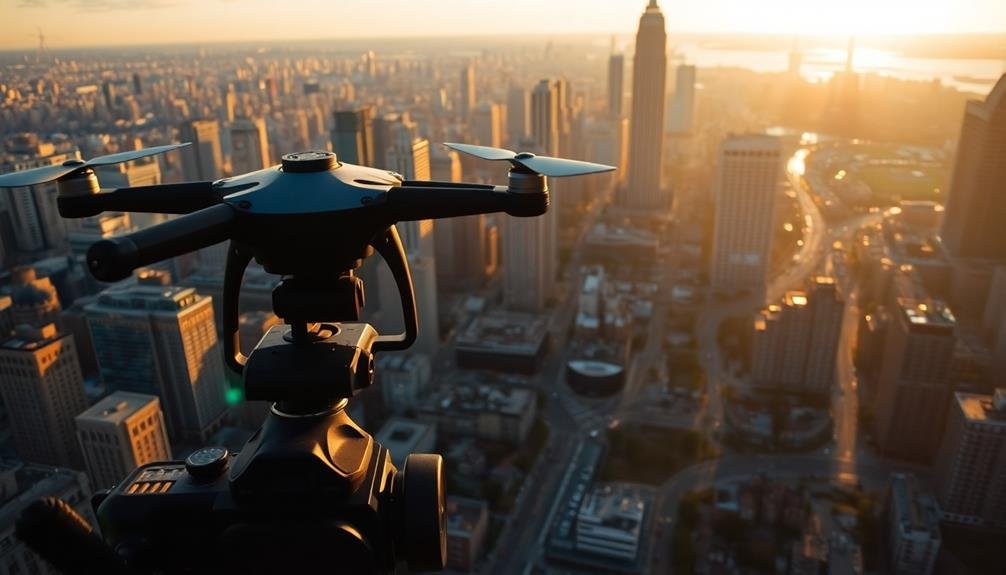Urban cinematography from soaring perspectives offers you breathtaking ways to capture cityscapes. You'll need reliable drones, ND filters, and post-production software to achieve stunning results. Master smooth flight techniques like orbiting and revealing while adhering to local regulations. Timing is essential; early morning or late afternoon light enhances architectural features. In post-production, focus on color correction and stabilization to perfect your footage. Get creative by juxtaposing people with architecture and using time-lapse to showcase dynamic urban shifts. With these tools and techniques, you'll elevate your urban filmmaking to new heights. The sky's the limit for what you can achieve in urban aerial cinematography.
Capturing Urban Landscapes From Above

Soaring above the cityscape, aerial cinematography reveals a whole new perspective on urban landscapes.
You'll discover patterns and symmetry invisible from the ground, transforming familiar streets into abstract artworks. Drones have revolutionized this field, allowing you to capture stunning footage without the need for expensive helicopter rentals.
To excel in aerial urban cinematography, you'll need to master your drone's controls and understand local flight regulations.
Practice smooth movements and plan your shots carefully, considering the time of day and weather conditions. Early morning or late afternoon light can cast long shadows, accentuating the city's architecture.
Look for leading lines in roads and rivers to guide the viewer's eye through the frame.
Capture the contrast between densely packed buildings and open spaces like parks or waterfronts. You can create dynamic shots by flying through narrow gaps between skyscrapers or following traffic patterns.
Post-processing is essential for enhancing your aerial footage.
Adjust color grading to bring out the city's unique character, and stabilize shaky shots for a professional look.
With practice, you'll develop a signature style that showcases urban landscapes in intriguing new ways.
Equipment for Aerial Urban Cinematography

Equipping yourself for aerial urban cinematography requires careful consideration of your gear. You'll need a reliable drone capable of stable flight and high-quality image capture. Popular models like the DJI Mavic 3 or Autel EVO II Pro offer 4K or even 6K video resolution, perfect for cinematic urban shots.
Invest in a set of ND filters to control light exposure and achieve smoother motion blur in your footage. A sturdy carrying case is essential to protect your equipment during transport. Don't forget extra batteries and propellers for extended shooting sessions.
For ground control, you'll want a tablet or smartphone with a large, bright screen to clearly see your drone's live feed. A sun hood can improve visibility in bright outdoor conditions. Consider a dual-operator setup with a separate camera operator for complex shots.
Post-production equipment is vital too. A powerful computer with ample storage and a color-accurate monitor will help you edit and grade your footage effectively.
Software like Adobe Premiere Pro or DaVinci Resolve is essential for professional-level editing and color correction of your urban aerial cinematography.
Drone Flight Techniques for Cities

Urban landscapes present unique challenges for drone pilots. You'll need to navigate through a maze of buildings, power lines, and other obstacles while capturing stunning footage. To master urban drone cinematography, you'll need to develop specific flight techniques tailored to city environments.
Start by familiarizing yourself with local regulations and obtaining necessary permits. Practice flying in open areas before venturing into dense urban spaces. When you're ready to tackle the city, focus on smooth, controlled movements. Use gentle stick inputs to achieve fluid pans and tilts, creating cinematic shots that showcase the urban landscape.
Here are some essential techniques for urban drone cinematography:
- Orbit: Circle around a point of interest, maintaining a consistent distance and altitude
- Reveal: Start with a close-up of a building, then slowly pull back to reveal the cityscape
- Tracking shot: Follow a moving subject, such as a car or pedestrian, through city streets
- Vertical ascent: Slowly rise from street level to showcase the city's vertical scale
- Parallax effect: Fly past foreground objects to create depth and dimension in your shots
Remember to always prioritize safety and respect privacy laws when flying in urban areas.
Legal Considerations in Urban Filming

Legal considerations are paramount when filming in urban environments. You'll need to navigate a complex web of regulations to guarantee your urban cinematography project stays on the right side of the law.
Start by obtaining the necessary permits from local authorities. These may include filming permits, drone operation licenses, and location-specific authorizations.
Be aware of privacy laws and property rights. You can't film inside private buildings or capture footage of individuals without their consent.
Respect noise ordinances and traffic regulations to avoid disrupting city life. When using drones, you must adhere to FAA guidelines, including maintaining visual line of sight and avoiding no-fly zones.
Consider insurance requirements. Many cities mandate liability coverage for film productions. You'll also want to protect your equipment and crew.
Be mindful of copyright issues when capturing landmarks or artwork in your shots. Some iconic structures may require additional permissions.
Lastly, stay informed about local regulations specific to your filming location. Urban cinematography laws can vary greatly between cities and countries.
Post-Production for Urban Aerial Footage

Once you've wrapped up your urban aerial shoot, it's time to plunge into post-production.
You'll need to sort through your footage, selecting the best shots that showcase the city's unique character. Color correction is essential, as aerial footage often requires adjustments to balance exposure and enhance the urban palette.
Pay attention to stabilization, using software tools to smooth out any shaky footage and create seamless motion.
When editing, consider the pacing of your urban aerial sequences. Mixing long, sweeping shots with quicker cuts can create a dynamic rhythm that captures the energy of the city.
Don't forget to add sound design, incorporating ambient city noises or music that complements the visuals.
For a polished final product, consider these advanced post-production techniques:
- HDR color grading for enhanced dynamic range
- Parallax effects to add depth to still images
- 3D tracking for seamless integration of visual effects
- Time-lapse sequences to show urban patterns and movement
- Lens distortion correction for professional-looking wide-angle shots
Creative Storytelling With City Skylines

You can elevate your urban cinematography by creatively framing iconic landmarks within your shots, capturing the essence of a city's identity.
Consider employing time-lapse techniques to showcase the dynamic shifts of skylines from day to night, revealing the pulsing energy of urban environments.
Don't forget to juxtapose people against architectural backdrops, highlighting the intricate relationship between a city's inhabitants and its towering structures.
Framing Iconic Urban Landmarks
A city's iconic landmarks offer filmmakers endless possibilities for creative storytelling through urban cinematography. When framing these urban icons, you'll want to take into account their unique features and how they can enhance your narrative. By carefully positioning your camera, you can create striking compositions that capture the essence of the city while advancing your story.
To effectively frame iconic urban landmarks, keep these tips in mind:
- Use leading lines to draw the viewer's eye toward the landmark
- Experiment with different angles to reveal unexpected perspectives
- Incorporate foreground elements to add depth and context
- Play with lighting conditions to create dramatic or ethereal moods
- Utilize negative space to emphasize the landmark's significance
Remember that timing is significant when shooting urban landmarks. Golden hour can bathe structures in warm, flattering light, while blue hour can create a mesmerizing contrast between the darkening sky and illuminated buildings.
Don't be afraid to revisit locations at different times of day or in various weather conditions to capture diverse moods and atmospheres. By mastering the art of framing iconic urban landmarks, you'll elevate your urban cinematography and create compelling visual narratives that resonate with your audience.
Time-Lapse Skyline Transitions
As day turns to night, time-lapse skyline shifts offer a powerful tool for urban cinematographers to convey the passage of time and the dynamic nature of city life.
You'll want to set up your camera in a strategic location with a clear view of the skyline, ensuring it's stable and protected from the elements.
Choose your interval carefully; shorter intervals capture subtle changes, while longer ones create more dramatic shifts. You'll need to adjust your camera settings as light conditions change, often using a combination of aperture priority and manual modes.
Consider incorporating foreground elements to add depth and context to your shots. Moving clouds, changing traffic patterns, and shifting shadows can all enhance the visual story you're telling.
Don't limit yourself to just day-to-night shifts. Capture the city waking up at dawn, the hustle of rush hour, or the calm of late night. You can even create longer narratives by filming over multiple days or seasons.
In post-production, you'll stitch your images together and fine-tune the pacing to create a compelling visual journey through urban time and space.
Juxtaposing People and Architecture
Every urban cinematographer knows that the true essence of a city lies in the interplay between its people and its architecture. When you're capturing urban scenes, endeavor to juxtapose human elements with the built environment. This contrast creates a dynamic visual narrative that speaks volumes about the city's character.
To effectively blend people and architecture in your shots:
- Use scale to your advantage, showcasing towering skyscrapers alongside pedestrians
- Capture reflections in glass buildings to merge cityscapes with human activity
- Incorporate leading lines from architectural features to draw attention to people
- Utilize negative space in modern structures to frame human subjects
- Play with shadows cast by buildings to create interesting silhouettes of passersby
As you compose your shots, consider the story you're telling. Are you highlighting the hustle and bustle of urban life, or the sense of isolation one might feel in a concrete jungle?
Frequently Asked Questions
How Do I Minimize Reflections When Filming Urban Landscapes Through Glass Windows?
You can minimize reflections by using a polarizing filter, shooting at an angle, getting close to the glass, shading the lens, or filming at night. Clean the window thoroughly and avoid bright clothing that may reflect.
What Are the Best Times of Day for Capturing Dramatic Urban Shadows?
You'll capture the most dramatic urban shadows during early morning or late afternoon. These "golden hours" create long, striking shadows. Midday sun produces shorter shadows, while dusk offers subtle, diffused lighting effects on city structures.
How Can I Incorporate Urban Sounds Effectively in Aerial Cinematography?
You'll want to use high-quality microphones on your drone to capture city ambiance. Mix in street-level audio for depth. Edit carefully, balancing ambient sounds with music. Don't overpower visuals; let urban noise enhance your aerial footage subtly.
What Techniques Help Convey the Scale of Skyscrapers in Aerial Shots?
You'll convey skyscraper scale by using slow, vertical pans from bottom to top. Include people or vehicles for size comparison. Fly close to buildings, then pull away gradually. Capture reflections in glass facades for added depth.
How Do I Handle Sudden Weather Changes During Urban Aerial Filming Sessions?
You'll need to be flexible and prepared. Keep an eye on forecasts, but bring waterproof gear and lens filters. If conditions worsen, prioritize safety and consider rescheduling. Quick adaptations can lead to unique, dramatic shots.
In Summary
You've now explored the exciting world of urban aerial cinematography. From soaring cityscapes to intimate street scenes, you're equipped to capture stunning footage. Remember to master your equipment, hone your flight skills, and stay informed about local regulations. As you edit and craft your urban stories, you'll bring new perspectives to familiar landscapes. So grab your gear, take to the skies, and let your creativity soar above the city streets.

As educators and advocates for responsible drone use, we’re committed to sharing our knowledge and expertise with aspiring aerial photographers.




Leave a Reply